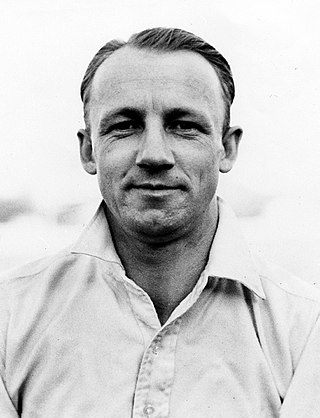
Sir Donald George Bradman, nicknamed "The Don", was an Australian international cricketer, widely acknowledged as the greatest batsman of all time. His cricketing successes have been claimed by Shane Warne, among others, to make Bradman the "greatest sportsperson" in history. Bradman's career Test batting average of 99.94 is considered by some to be the greatest achievement by any sportsman in any major sport.

Harold Larwood was a professional cricketer for Nottinghamshire County Cricket Club and the England cricket team between 1924 and 1938. A right-arm fast bowler who combined extreme speeds with great accuracy, he was considered by many players and commentators to be the finest and the fastest fast bowler of his generation and one of the fastest bowlers of all time. He was the main exponent of the bowling style known as "bodyline", the use of which during the Marylebone Cricket Club (MCC) tour of Australia in 1932–33 caused a furore that brought about a premature and acrimonious end to his international career.
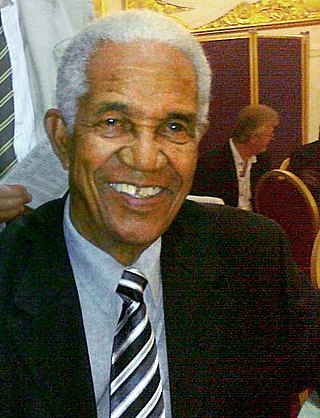
Sir Garfield St Aubrun Sobers, AO, OCC, also known as Sir Gary or Sir Garry Sobers, is a former Barbadian cricketer who played for the West Indies between 1954 and 1974. A highly skilled bowler, an aggressive batsman and an excellent fielder, he is widely considered to be cricket's greatest ever all-rounder and one of the greatest cricketers of all time.
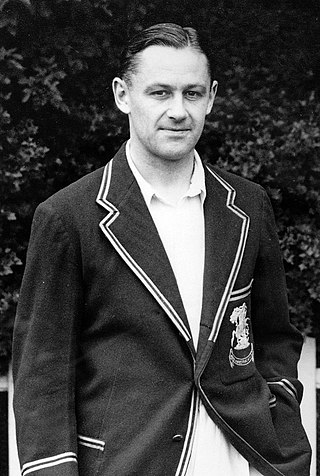
Sir George Oswald Browning "Gubby" Allen CBE was a cricketer who captained England in eleven Test matches. In first-class matches, he played for Middlesex and Cambridge University. A fast bowler and hard-hitting lower-order batsman, Allen later became an influential cricket administrator who held key positions in the Marylebone Cricket Club (MCC), which effectively ruled English cricket at the time; he also served as chairman of the England selectors.
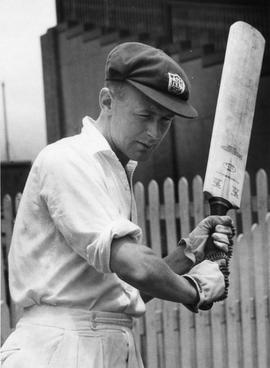
Arthur Robert Morris was an Australian cricketer who played 46 Test matches between 1946 and 1955. An opener, Morris is regarded as one of Australia's greatest left-handed batsmen. He is best known for his key role in Don Bradman's Invincibles side, which made an undefeated tour of England in 1948. He was the leading scorer in the Tests on the tour, with three centuries. His efforts in the Fourth Test at Headingley helped Australia to reach a world record victory target of 404 on the final day. Morris was named in the Australian Cricket Board's Team of the Century in 2000 and was inducted into the Australian Cricket Hall of Fame in 2001.

Stanley Joseph McCabe was an Australian cricketer who played 39 Test matches for Australia from 1930 to 1938. A short, stocky right-hander, McCabe was described by Wisden as "one of Australia's greatest and most enterprising batsmen" and by his captain Don Bradman as one of the great batsmen of the game. He was never dropped from the Australian Test team and was known for his footwork, mastery of fast bowling and the hook shot against the Bodyline strategy. He also regularly bowled medium-pace and often opened the bowling at a time when Australia lacked fast bowlers, using an off cutter. He was one of the Wisden Cricketers of the Year in 1935.
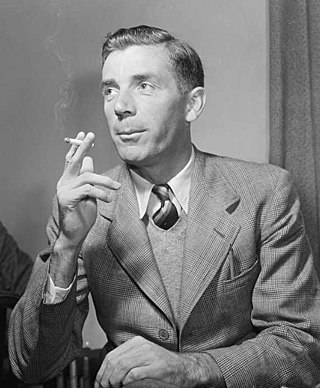
Douglas Vivian Parson Wright was an English cricketer. A leg-spinner for Kent and England from 1932 to 1957 he took a record seven hat-tricks in first-class cricket. He played for Kent for 19 seasons and was their first professional captain from late 1953 to 1956. Don Bradman said he was the best leg-spinner to tour Australia since Sydney Barnes, and Keith Miller thought he was the best leg-spinner he had seen apart from Bill O'Reilly. He toured Australia in 1946–47 and 1950–51, but was dogged by ill-luck and was considered to be the "unluckiest bowler in the world".
Cutting a leg-break is always dangerous, and cutting Wright is a form of suicide. Why a bowler of his skill failed to get more test-match wickets always mystified me; there was of course the marked tendency to bowl no-balls, but he sent down so many good ones, and worried and beat the batsmen so often, that he should have had better results...he seemed always likely to get wickets. It is one of the toughest problems of captaincy to know when to remove a man like that from the firing-line.
The English cricket team in Australia in 1946–47 was captained by Wally Hammond, with Norman Yardley as his vice-captain and Bill Edrich as the senior professional. It played as England in the 1946–47 Ashes series against the Australians and as the MCC in their other matches on the tour. They were regarded as a sound team which was just as strong as Australia, but due to the Second World War they were an ageing side and their bowling depended heavily on Alec Bedser and Doug Wright, who were overused and exhausted as a result. Australia beat England 3-0 in a five-match series to retain the Ashes; England suffered the worst defeat in a Test series since losing 4–1 to Australia in 1924–25. Since 1881, Tests in Australia were played to finish. That rule was changed for this series, and for the first time in 65 years, a test played in Australia ended in a draw when the third test was drawn.
M.J.K. Smith captained the English cricket team in Australia in 1965–66, playing as England in the 1965-66 Ashes series against the Australians and as the MCC in their other matches on the tour. The 5-Tests series ended in 1–1 draw. Although they failed to reclaim the Ashes this was not unexpected as the Australian press labelled them the weakest MCC team to arrive in Australia and the bookmakers were giving odds of 7/2 on their winning the series. These views rapidly changed as they set about winning their state matches with exciting, aggressive cricket and by the First Test the odds against them had been reduced to evens. Lindsay Hassett said "other teams from England may have been better technically but none had tried so hard to make the game as interesting as possible". Financially the tour's receipts were much lower than in 1962–63 due to the number of rain-affected games in a wet Australian summer and the general doldrums of the sixties.
Mike Denness captained the English cricket team in Australia in 1974–75, playing as England in the 1974-75 Ashes series against the Australians and as the MCC in their other matches on the tour. They lost the Test series and the Ashes 4–1 thanks to the battering they received from the fast bowling of Dennis Lillee and Jeff Thomson, but won the One Day International and with Lillee and Thomson injured they came back to win the Sixth Test by an innings.
The India national cricket team toured Australia in the 1947–48 season to play a five-match Test series against Australia. Australia won the series 4–0, with one match drawn.

The 1954–55 Ashes series consisted of five cricket Test matches, each of six days with five hours play each day and eight ball overs. It formed part of the MCC tour of Australia in 1954–55 and the matches outside the Tests were played in the name of the Marylebone Cricket Club. The England team was captained by Len Hutton, the first professional cricketer to lead an MCC tour of Australia. The Australian team under Ian Johnson was confident of victory, but despite losing the First Test by an innings England won the series 3–1 and retained the Ashes. They were the only touring team to win a series in Australia between 1932–33 and 1970–71 and only the second of three touring teams to win a series in Australia from behind. The tour is best remembered for the bowling of Frank "Typhoon" Tyson, who was at the time regarded as the fastest, most frightening bowler ever seen in Australia. The series saw a phenomenal concentration of bowling prowess on both sides – four of the bowlers had career Test averages under 21, another five under 25 and the remaining four under 30. Unsurprisingly therefore, the ball dominated the bat for most of the series and each side only topped 300 in an innings twice. Unlike the following series in 1958–59 there were rarely any umpiring disputes and Keith Miller wrote "Mel McInnes, Colin Hoy and Ron Wright were our leading umpires in the 1954–55 M.C.C. tour of Australia, and I have no hesitation in saying that McInnes gave the finest exhibition of umpiring in a Test series that I have experienced".

The 1970–71 Ashes series was the 45th edition of the long-standing cricket rivalry between England and Australia. Starting on 27 November 1970, the two sides ended up playing seven Tests; six were originally scheduled, but one extra Test was added to compensate for the abandoned Third Test.
The 1970–71 Australians lost 2–0 to the touring England team in the 1970–71 Ashes series. Australia had not lost a home Test series since 1954–55, but had suffered a heavy 4–0 defeat in South Africa in 1969–70 which had affected their confidence. On paper they should have had a good team, and E.W. Swanton reckoned they were favourites to hold on to The Ashes, but Rod Marsh, Dennis Lillee and Greg Chappell had yet to mature and Bill Lawry, Garth McKenzie and John Gleeson were at the end of their careers. In more fortunate circumstances the senior players could have eased the newcomers into the team, but Ray Illingworth was a captain who exploited every weakness and they did not get the chance. Their cause was not helped by the selectors Sir Donald Bradman, Sam Loxton and Neil Harvey who chose nineteen different players in the series, nine of them debutants, and continuously chopped and changed the team which did not allow it to settle.
The England team disputed several umpiring decisions in the 1970–71 Ashes series, Ray Illingworth, Geoffrey Boycott and John Snow in particular. After the series Boycott and Snow were called to a disciplinary hearing at Lords over their behaviour, and Illingworth and Snow never toured again. Only three umpires were used; Lou Rowan, who was most involved in the controversy, and his colleagues Tom Brooks and Max O'Connell who both debuted as Test umpires in the series. At the time, umpires had no recourse to slow motion replays and had to make decisions based on what they saw in a split second, with the benefit of the doubt always going to the batsman. As a result it was not uncommon for umpires to make mistakes, which over the course of a long series tended to cancel each other out. The best an umpire could do was to make an honest judgement based on what he saw.

The 1965–66 Ashes series consisted of five cricket Test matches, each of five days with six hours play and eight ball overs. It formed part of the MCC tour of Australia in 1965–66 and the matches outside the Tests were played in the name of the Marylebone Cricket Club. M.J.K. Smith led the England team with the intent on regaining the Ashes lost in the 1958–59 Ashes series, but the series was drawn 1-1 and they were retained by Australia. The Australian team was captained by Bobby Simpson in three Tests, and his vice-captain Brian Booth in two Tests.
The 1965-66 Australians drew 1-1 with the touring England team in the 1965-66 Ashes series. They were strong in batting, but weak in bowling and by the end of the series had seven batsmen, an all-rounder, a wicket-keeper and only two specialist bowlers in the team, with the batsman helping out with their part-time bowling skills.

The 1946–47 Ashes series consisted of five cricket Test matches, each of six days with five hours play each day and eight ball overs. Unlike pre-war Tests in Australia, matches were not timeless and played to a finish. It formed part of the MCC tour of Australia in 1946–47 and England played its matches outside the Tests in the name of the Marylebone Cricket Club. The England team was led by the veteran Wally Hammond and his vice-captain Norman Yardley with the strong batting line up of Len Hutton, Cyril Washbrook, Bill Edrich, Denis Compton and Joe Hardstaff, but a weak bowling attack that relied on pre-war bowlers like the 37-year-old Bill Voce of Bodyline fame and the mercurial leg-spinner Doug Wright. The two successes of the tour were the newly capped Alec Bedser, who would carry the England bowling attack until 1955, and Godfrey Evans who would be England's first choice wicketkeeper until 1959. England had drawn the Victory Tests 2–2 in 1945 and were thought to be equal in strength, but Hammond lost 3–0 to Don Bradman's Australian team which had only two other pre-war players – Lindsay Hassett and Sid Barnes, who had played 5 Tests between them – and was packed with fresh talent in the shape of Arthur Morris, Keith Miller, Ray Lindwall, Colin McCool, Ernie Toshack and Don Tallon. There were several controversial umpiring decisions which assumed greater significance as they favoured Australia and in particular Don Bradman.
The 1946–47 Australians defeated the touring England team 3–0 in the 1946–47 Ashes series. First-class cricket had continued in Australia until January 1942 and as grade cricket had continued throughout the war there had been less of an hiatus than in England. Their cricket grounds had not been bombed and compared to austerity Britain, Australia was a land of plenty, which allowed for a more rapid recovery than in the old country, as had happened after the First World War. There was no Sheffield Shield in 1945–46, but the Australian Services XI had played all the states and there had been non-Shield interstate games. However, Australia's main advantage was the encouragement of their younger players, in particular by Bradman. Though overshadowed by the great 1948 Australian team, in 1975 Don Bradman reckoned that it was Australia's strongest post-war home team, with the 1974–75 Australians coming a close second and the 1950–51 Australians third. It was also superior to the pre-war Australian teams, as though they were just as strong in batting they had no fast bowlers and depended heavily on the leg-spin of Clarrie Grimmett and Bill O'Reilly. In 1946–47 Ray Lindwall and Keith Miller emerged as a great new-ball partnership, with quality support from Ernie Toshack, Ian Johnson and Colin McCool. The only area for improvement was in finding another top-order strokemaker, which was soon resolved by the arrival of Neil Harvey.
The 1974–75 Australians beat the touring England team 4–1 in the 1974-75 Ashes series. Labelled the Ugly Australians for their hard-nosed cricket, sledging, and hostile fast bowling, they are regarded as one of the toughest teams in cricket history. Don Bradman ranked them just after his powerful teams of the late 1940s, and Tom Graveney third amongst post-war cricket teams after the 1948 Australians and 1984 West Indians. The spearhead of the team was the fast-bowling duo of Dennis Lillee, whose hatred of English batsmen was well known, and Jeff Thomson, who outraged old fashioned cricketers by saying he liked to see "blood on the wicket". Wisden reported that "never in the 98 years of Test cricket have batsmen been so grievously bruised and battered by ferocious, hostile, short-pitched balls". "Behind the batsmen, Rod Marsh and his captain Ian Chappell would vie with each other in profanity", but the predatory wicketkeeper and Australian slip cordon snapped up most chances that came their way. Their batting line up was also impressive with the opener Ian Redpath spending over 32 hours at the crease in the series, followed by Rick McCosker, Ian and Greg Chappell, Doug Walters and Ross Edwards. In the last Test of the series Lillee and Thomson were injured, the out of form England captain Mike Denness made 188 and England won by an innings.









